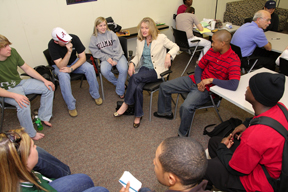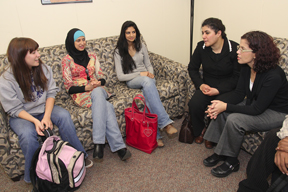Sheri Spaine Long, Ph.D., enjoys showing up unannounced at a Foreign Languages & Literatures Conversation Table and talking to students.
 |
| Sheri Spaine Long, top, talks with students at a recent Spanish conversation table gathering in the Humanities Building. The conversation tables are a meeting time for students, outside class, to practice the language they are learning by conversing with others. Lamia Zayzafoon’s Arabic table, bottom, was added just one year ago, and the department now has tables for eight different languages. |
 |
Long, the chair of the department, says the beginning of a semester always is the best time to visit. She’ll walk in – usually to a Spanish Table – and start conversing with the students in Spanish. “Hello. How is your day going? Are you enjoying things so far? What’s your major?”
Many of the students don’t realize she chairs the department.
“They kind of look at you at first like ‘Who is she and why is she here?’” Long says. “But the conversation tables are good for me, too. I know when my Spanish is getting a little rusty and needs some work. That’s what the table is designed to do. It’s language maintenance.”
A conversation table is a meeting time for students, outside class, to practice the language they are learning by conversing with others. The tables also provide the opportunity for fluent speakers to hone their skills. “Learning a language and continuing to speak it well is like riding a bike,” Long says. “You won’t remember how to speak it in 30 years without consistent practice.”
Laidback language learning
The department has seen a growing interest from students in these informal gatherings. Consequently, the diversity of languages spoken at the tables has expanded. Arabic, Chinese, French, German, Italian, Japanese, Russian and Spanish all are offered. The tables meet in the Humanities Building, at the Commons on the Green, in the dorms and other places around campus.
“We used to offer only three tables, and now we’ve got about 10,” Long says. “It’s become a major job to get them all scheduled and staffed, but it speaks positively to the commitment to language learning on campus and in the community.”
Lamia Zayzafoon, Ph.D., who oversees the Arabic table, says participants come from a wide range of disciplines.
“We have students in medicine, business, anthropology, international studies and the Army, to name a few,” Zayzafoon says. “We also have heritage students — Arab-Americans who want to learn the language of their grandparents.”
Zayzafoon says students who attend may read headlines of Arab newspapers or sing as a way of learning the language. Conversations focus largely on day-to-day life in an effort to set a foundation for learning one of the world’s most complicated languages.
“We talk about their major, their professions, their family, their hobbies,” Zayzafoon says. “It’s really an extension of what we are doing in Arabic 101 and 102, but it’s in a more relaxed setting.”
Foreign-language teachers, Fulbright teaching assistants, visiting students and community members moderate the conversations.
“There’s a Spanish table that meets in the dorms at night during the week that apparently has the largest attendance of all,” Long says. “Almost 25 people show up regularly to speak Spanish for an hour-and-a-half.
“That’s invaluable to the students learning the language,” she explains. “They are doing two things – making the time to learn it and learning from someone around their age who comes from the foreign culture. They bring current cultural information into the conversation that I think the students particularly enjoy.”
Spanish tables are the most popular with five sessions offered, including a medical Spanish conversation table conducted by department Instructor Maria Centeno.
“I have medical students who want to learn some basic concepts of communicating to Spanish-speaking people,” Centeno says. “In the medical table they learn more practical conversation and ask very particular questions. They are thinking about real problems they have to face in their careers.”
The tables have grown so quickly that Long hopes to add more Fulbright teaching assistants for the fall to meet demand.